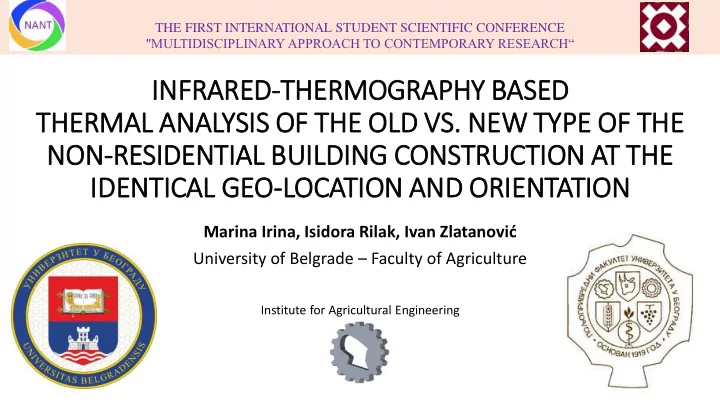

THE FIRST INTERNATIONAL STUDENT SCIENTIFIC CONFERENCE "MULTIDISCIPLINARY APPROACH TO CONTEMPORARY RESEARCH“ INFRARED-THERMOGRAPHY BASED INF THE HERMAL ANALYSIS OF THE HE OLD LD VS. . NEW TYP YPE OF THE HE NON-RESIDENTIAL BU BUILDING CONSTRUCTION AT THE HE IDE IDENTICAL GEO-LOCATION AND ORIENTATION Marina Irina, Isidora Rilak, Ivan Zlatanović University of Belgrade – Faculty of Agriculture Institute for Agricultural Engineering
The First International Student Scientific Conference "Multidisciplinary Approach to Contemporary Research" What is Infrared Thermography (IRT)? Infrared thermography is equipment or method , which detects infrared energy emitted from object, converts it to temperature , and displays image of temperature distribution.
The First International Student Scientific Conference "Multidisciplinary Approach to Contemporary Research" Why use Infrared Thermography (IRT)? Infrared thermography is the only diagnostic technology that lets you instantly visualize and verify thermal performance with non-contact temperature measurement.
The First International Student Scientific Conference "Multidisciplinary Approach to Contemporary Research" Our Research • The headquarter building of the Faculty of Agriculture (Belgrade) was analyzed. • It consists of old and new building that relies one on another. • IRT methodology was used to provide useful information regarding the two types of façade’s wall construction (i.e. building envelopes). • Buildings envelope thermal behavior was analyzed (the benefits and faults).
The First International Student Scientific Conference "Multidisciplinary Approach to Contemporary Research" The buildings model
The First International Student Scientific Conference "Multidisciplinary Approach to Contemporary Research" Building Old New Solid wall The old and new Solid wall building comparative information Exposed wall Thermal conductivity: 1.46 W/mK Thickness: 0.25 m Panel wall The differences between these two types of building constructions Material: Insulated aluminum metal panel Thermal conductivity: 0.62 W/mK Thermal conductivity: 0.63 W/mK was observed from the technical Thickness: 0.60 m Thickness: 0.08 m joinery and architectural main project documentation. Window materials glass + wood glass + aluminum metal glass quality clear, 4 mm toned, 15%, 4 mm glazing secondary, 1+1, double, 8 mm cavity thermal 2.8 W/mK 3.1 W/mK conductivity
The First International Student Scientific Conference "Multidisciplinary Approach to Contemporary Research" IRT recordings New building (WEST SIDE) Old building (EAST SIDE)
The First International Student Scientific Conference "Multidisciplinary Approach to Contemporary Research" IRT recordings Old and new building (NORTH SIDE) The comparison areas was 50 m 2 on old and the same area on new building (boxes are highlighted) The indoor temperature was found to be +19°C during the conducted IRT recordings.
The First International Student Scientific Conference "Multidisciplinary Approach to Contemporary Research" Results Old and new building outdoor surface temperature histogram Captured outdoor wall surface temperatures of old building are average lower than one of the new building for approximately 0.5 ÷ 2 ° C. The specific heat flow rate through the envelope: old building 6.76 W/m 2 , new building 15.18 W/m 2 .
The First International Student Scientific Conference "Multidisciplinary Approach to Contemporary Research" Results 3D-IRT diagram of building outdoor surface temperatures The hottest areas are on the new building joineries, meaning that those surfaces are the one with the biggest heat losses (appearance of the thermal bridges). The thermal behavior of new building joineries increases the heat losses through new building envelope.
The First International Student Scientific Conference "Multidisciplinary Approach to Contemporary Research" Results 3D-IRT diagram (thermal bridges locations)
The First International Student Scientific Conference "Multidisciplinary Approach to Contemporary Research" Conclusions • Results were in favor on old building construction style and choice of built in materials. Old building envelope specific heat flow rate was 6.76 W/m 2 (vs. 15.18 W/m 2 of the new one). • • The new building has greater heat losses because of the large areas made of metal thermal insulation panels . • The appearance of thermal bridges at new building joinery increased heat losses.
The First International Student Scientific Conference "Multidisciplinary Approach to Contemporary Research" Thank you for your attention !
Recommend
More recommend